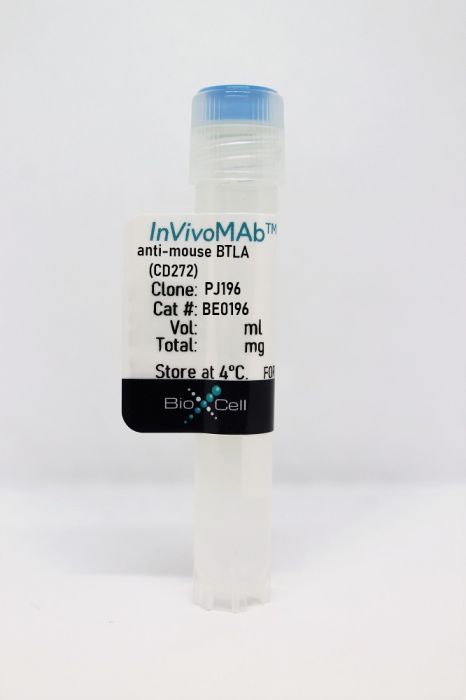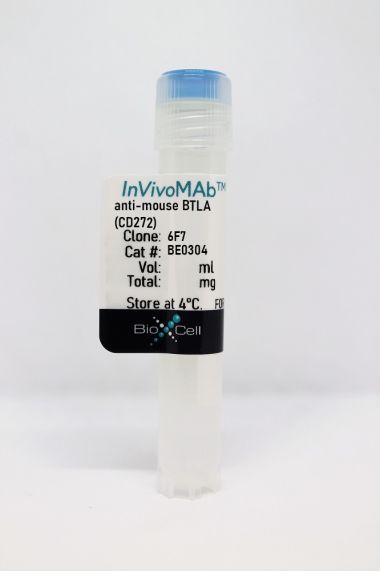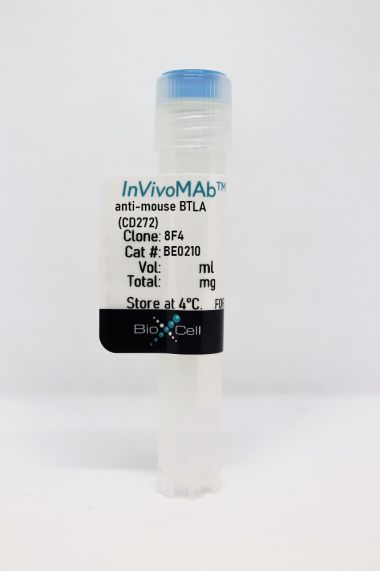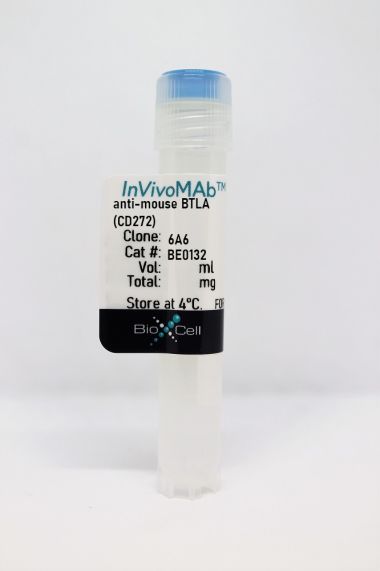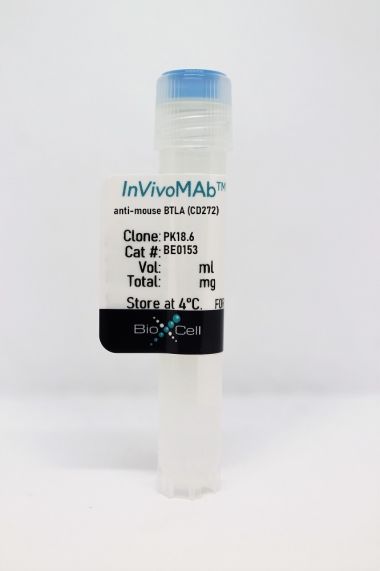InVivoMAb anti-mouse BTLA (CD272)
Product Details
The PJ196 monoclonal antibody reacts with mouse B- and T-lymphocyte attenuator (BTLA) also known as CD272. BTLA is an Ig superfamily member which is expressed on B cells, T cells, macrophages, dendritic cells, NK cells, and NKT cells. Like PD-1 and CTLA-4, BTLA interacts with a B7 homolog, B7-H4. However, unlike PD-1 and CTLA-4, BTLA displays T cell inhibition via interaction with tumor necrosis family receptors, not just the B7 family of cell surface receptors. BTLA is a ligand for herpes virus entry mediator (HVEM). BTLA-HVEM complexes have been shown to negatively regulate T cell immune responses.Specifications
| Isotype | Mouse IgG1 |
|---|---|
| Recommended Isotype Control(s) | InVivoMAb mouse IgG1 isotype control, unknown specificity |
| Recommended Dilution Buffer | InVivoPure pH 7.0 Dilution Buffer |
| Conjugation | This product is unconjugated. Conjugation is available via our Antibody Conjugation Services. |
| Immunogen | Not available or unknown |
| Reported Applications |
in vivo BTLA blockade in vitro T cell stimulation/activation Flow cytometry |
| Formulation |
PBS, pH 7.0 Contains no stabilizers or preservatives |
| Endotoxin |
<2EU/mg (<0.002EU/μg) Determined by LAL gel clotting assay |
| Purity |
>95% Determined by SDS-PAGE |
| Sterility | 0.2 µm filtration |
| Production | Purified from cell culture supernatant in an animal-free facility |
| Purification | Protein G |
| RRID | AB_10949056 |
| Molecular Weight | 150 kDa |
| Storage | The antibody solution should be stored at the stock concentration at 4°C. Do not freeze. |
Recommended Products
Flow Cytometry
Krieg, C., et al. (2007). "B and T lymphocyte attenuator regulates CD8+ T cell-intrinsic homeostasis and memory cell generation" Nat Immunol 8(2): 162-171. PubMed
B and T lymphocyte attenuator (BTLA) is a negative regulator of T cell activation, but its function in vivo is not well characterized. Here we show that mice deficient in full-length BTLA or its ligand, herpesvirus entry mediator, had increased number of memory CD8(+) T cells. The memory CD8(+) T cell phenotype resulted from a T cell-intrinsic perturbation of the CD8(+) T cell pool. Naive BTLA-deficient CD8(+) T cells were more efficient than wild-type cells at generating memory in a competitive antigen-specific system. This effect was independent of the initial expansion of the responding antigen-specific T cell population. In addition, BTLA negatively regulated antigen-independent homeostatic expansion of CD4(+) and CD8(+) T cells. These results emphasize two central functions of BTLA in limiting T cell activity in vivo.
in vivo BTLA blockade
Truong, W., et al. (2007). "Negative and positive co-signaling with anti-BTLA (PJ196) and CTLA4Ig prolongs islet allograft survival" Transplantation 84(10): 1368-1372. PubMed
The novel coinhibitory receptor B and T lymphocyte attenuator (BTLA) has been implicated in the regulation of autoimmune and may potentially play a role in alloimmune responses. An anti-BTLA monoclonal antibody has been reported to prolong fully major histocompatibility complex-mismatched cardiac allograft survival, and we test the hypothesis that anti-BTLA monoclonal antibody PJ196 may synergize with cytotoxic T lymphocyte antigen-4 immunoglobulin (CTLA4Ig) costimulatory blockade in islet transplantation. We investigated the potential of PJ196, and show that it did not deplete BTLA expressing cells, but it caused down-regulation of BTLA on the surface of lymphocytes and accumulation of cells with regulatory phenotype at the graft site, promoting islet allograft acceptance together with CTLA4Ig. The combination of BTLA coinhibitory modulation and CTLA4Ig costimulatory blockade may be an effective adjunctive strategy for inducing long-term allograft survival.
in vitro T cell stimulation/activation
Krieg, C., et al. (2005). "Functional analysis of B and T lymphocyte attenuator engagement on CD4+ and CD8+ T cells" J Immunol 175(10): 6420-6427. PubMed
T cell activation can be profoundly altered by coinhibitory and costimulatory molecules. B and T lymphocyte attenuator (BTLA) is a recently identified inhibitory Ig superfamily cell surface protein found on lymphocytes and APC. In this study we analyze the effects of an agonistic anti-BTLA mAb, PK18, on TCR-mediated T cell activation. Unlike many other allele-specific anti-BTLA mAb we have generated, PK18 inhibits anti-CD3-mediated CD4+ T cell proliferation. This inhibition is not dependent on regulatory T cells, nor does the Ab induce apoptosis. Inhibition of T cell proliferation correlates with a profound reduction in IL-2 secretion, although this is not the sole cause of the block of cell proliferation. In contrast, PK18 has no effect on induction of the early activation marker CD69. PK18 also significantly inhibits, but does not ablate, IL-2 secretion in the presence of costimulation as well as reduces T cell proliferation under limiting conditions of activation in the presence of costimulation. Similarly, PK18 inhibits Ag-specific T cell responses in culture. Interestingly, PK18 is capable of delivering an inhibitory signal as late as 16 h after the initiation of T cell activation. CD8+ T cells are significantly less sensitive to the inhibitory effects of PK18. Overall, BTLA adds to the growing list of cell surface proteins that are potential targets to down-modulate T cell function.
- In Vivo,
- Mus musculus (House mouse),
- Immunology and Microbiology
Herpesvirus Entry Mediator Binding Partners Mediate Immunopathogenesis of Ocular Herpes Simplex Virus 1 Infection.
In mBio on 12 May 2020 by Park, S. J., Riccio, R. E., et al.
PubMed
Ocular herpes simplex virus 1 (HSV-1) infection leads to an immunopathogenic disease called herpes stromal keratitis (HSK), in which CD4+ T cell-driven inflammation contributes to irreversible damage to the cornea. Herpesvirus entry mediator (HVEM) is an immune modulator that activates stimulatory and inhibitory cosignals by interacting with its binding partners, LIGHT (TNFSF14), BTLA (B and T lymphocyte attenuator), and CD160. We have previously shown that HVEM exacerbates HSK pathogenesis, but the involvement of its binding partners and its connection to the pathogenic T cell response have not been elucidated. In this study, we investigated the role of HVEM and its binding partners in mediating the T cell response using a murine model of ocular HSV-1 infection. By infecting mice lacking the binding partners, we demonstrated that multiple HVEM binding partners were required for HSK pathogenesis. Surprisingly, while LIGHT-/-, BTLA-/-, and CD160-/- mice did not show differences in disease compared to wild-type mice, BTLA-/- LIGHT-/- and CD160-/- LIGHT-/- double knockout mice showed attenuated disease characterized by decreased clinical symptoms, increased retention of corneal sensitivity, and decreased infiltrating leukocytes in the cornea. We determined that the attenuation of disease in HVEM-/-, BTLA-/- LIGHT-/-, and CD160-/- LIGHT-/- mice correlated with a decrease in gamma interferon (IFN-γ)-producing CD4+ T cells. Together, these results suggest that HVEM cosignaling through multiple binding partners induces a pathogenic Th1 response to promote HSK. This report provides new insight into the mechanism of HVEM in HSK pathogenesis and highlights the complexity of HVEM signaling in modulating the immune response following ocular HSV-1 infection.IMPORTANCE Herpes simplex virus 1 (HSV-1), a ubiquitous human pathogen, is capable of causing a progressive inflammatory ocular disease called herpes stromal keratitis (HSK). HSV-1 ocular infection leads to persistent inflammation in the cornea resulting in outcomes ranging from significant visual impairment to complete blindness. Our previous work showed that herpesvirus entry mediator (HVEM) promotes the symptoms of HSK independently of viral entry and that HVEM expression on CD45+ cells correlates with increased infiltration of leukocytes into the cornea during the chronic inflammatory phase of the disease. Here, we elucidated the role of HVEM in the pathogenic Th1 response following ocular HSV-1 infection and the contribution of HVEM binding partners in HSK pathogenesis. Investigating the molecular mechanisms of HVEM in promoting corneal inflammation following HSV-1 infection improves our understanding of potential therapeutic targets for HSK. Copyright © 2020 Park et al.

